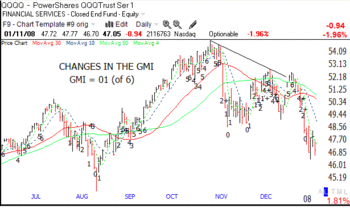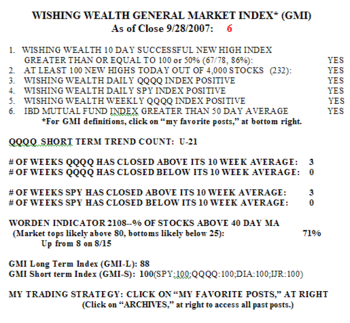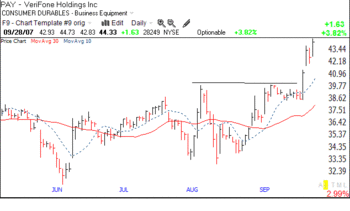The GMI and GMI-R remain at zero. On Monday, there were 69 new highs and 189 new lows in my universe of 4,000 stocks. Thank you for the nice comments about yesterday’s post about Nicolas Darvas. It appears we are finally getting the earnings bounce. The key is whether this rally in the QQQQ can break above the last peak at 52.63. Monday’s rally came on relatively low volume and may turn out to be a dead cat bounce. We may have to wait for earnings season to be completed before this market reveals itself. The winning strategy for me is to react after a turn and not to anticipate one. For now, cash is king.
Nicolas Darvas
GMI:0; GMI-R:0; Nicolas Darvas on staying clear of bear markets
The GMI and GMI-R remain at zero. The down-trend in the QQQQ is in place. So, what to do when only 40 of the 4,000 stocks in my universe of stocks hit a new high on Friday while 232 hit new lows? Friday was the 7th day in the current QQQQ short term down-trend and the GMI has been less than 3 for the past 8 days. (Click on chart to enlarge.) The GMI has registered zero for the past six days. So, I have been telling you how I have been mainly in cash. I only play when the odds are in my favor. So why do the media pundits, including Cramer, continually look for stocks to buy? Why are they looking for safe stocks in a rotten market? I must assume they make no money and have no audience if the public stays away during bad markets. It is because I was angry at how these mental midgets misled the public in the 2000-2002 debacle that I began this blog. I want to educate the little person as to how I have protected myself from the major market declines since 1995.
The GMI has registered zero for the past six days. So, I have been telling you how I have been mainly in cash. I only play when the odds are in my favor. So why do the media pundits, including Cramer, continually look for stocks to buy? Why are they looking for safe stocks in a rotten market? I must assume they make no money and have no audience if the public stays away during bad markets. It is because I was angry at how these mental midgets misled the public in the 2000-2002 debacle that I began this blog. I want to educate the little person as to how I have protected myself from the major market declines since 1995.
So, if you still are unconvinced, listen to what the genius trader, Nicolas Darvas said about bear markets. Darvas, as you will recall from my favorite post on him (see bottom right), made a fortune in the bull market of the late 1950’s as he traded part-time and literally danced around the world. In a rare sequel to his best-seller of 1960 (You Can Still Make It In The Market, published in 1977) , Darvas wrote about bear markets. This book was written after Darvas had experienced the painful market declines in 1970 and 1974.
…..I like to be sure the odds are in my favor. If the market is in a down-trend and the industry group is performing weakly I know that the cards are stacked against me and that my chances of making big profits are poorer than if the market and the industry are strong. You cannot be too careful in the stock market. …………….There have been any number of stocks that have multiplied in price manyfold in a bear market, just as there are plenty of stocks that have hardly moved in a bull market. But my temperament is such that I would rather be safe than sorry. So I keep out in a bear market and leave such exceptional stocks to those who don’t mind risking their money against the market trend……………..
Many people seem to think they must always keep their money “working,” i.e. constantly invested in stocks. But why remain invested in a bear market when everything is dropping? Why ride the market up and down and lose on the downside what you have so painstakenly made on the upside?……There are even some people who believe that a policy of “buy and hold” is the best, so they hang on through thick and thin. Presumably they get some masochistic pleasure from seeing their capital melt before their eyes every two or three years in successive bear cycles, or they just close their eyes, grit their teeth, and sit it out. With that sort of approach stock-market investment becomes a succession of nightmares. I prefer to sleep soundly at night, even if it means going into cash for long periods.
Oh that we had more highly visible experts like Darvas, speaking accurately about the stock market! Instead the pundits of the day try to scare us into stocks, lest we miss the next rise. But no one knows when the turn will come and there is plenty of time to jump on a real bull move. So I sit on the sideline during this down-trend, comfortably in cash, and wait for the GMI and the market to turn………………
GMI: 6; IBD100 stocks do outperform; Meet Judy, a great stock-picker
The GMI remains at a maximum value of 6 and the current QQQQ short-term up-trend completed its 21st day (U-21) on Friday.  What a great September—my account rose a little more than 5% for the month. Almost all (90%) of the stocks I wrote calls on were called away from me in my IRA. Writing short term (present month) calls on IBD100 stocks in up-trends has proved to be a highly successful and profitable strategy. Someday I will describe how I do it….
What a great September—my account rose a little more than 5% for the month. Almost all (90%) of the stocks I wrote calls on were called away from me in my IRA. Writing short term (present month) calls on IBD100 stocks in up-trends has proved to be a highly successful and profitable strategy. Someday I will describe how I do it….
I have heard traders claim that the IBD100 stock list is a list for “suckers” because by the time that stocks appear on this list, they are ready to fall. Nothing could be further from the truth. Like all stocks, the IBD100 move with the overall direction of the market. I looked at the 100 stocks published on the list in IBD on Monday, 8/20. Since the prior Friday’s close (8/17) through last Friday’s close (9/28), the Nasdaq 100 index has climbed 11%, but the median stock on the IBD100 list is up 15.6%. Most important, almost half (42/100) of the stocks on that IBD100 list are up 20% or more. During the same period, only 12% of the Nasdaq 100 stocks and less than 4% of the S&P500 stocks rose 20%or more. So, the IBD100 stocks list is a prime place to look for stocks that will outperform in a rising market. Sort of a no-brainer and another busted myth….
Speaking of brains, I have met a woman, Judy, who does exquisite research into stocks and has selected a number of companies that later get bought out. She tends to find these nuggets before the stocks move up and show up in my technical scans of the market. I wanted to show you how I can still marry her talent for picking great stocks with my technical approach. Judy recently told me she was interested in PAY because of its connections to China. PAY produces those machines that make it possible to scan your charge card quickly at the cash register. With the Olympics coming and Chinese merchants preparing for the onslaught of tourists and sales, Judy thought this company was promising (this was only one of her reasons for liking PAY).  So, I went to the charts in mid-September and noticed that PAY (an IBD100 stock) had formed a base (maybe a cup-with-handle) and was consolidating after a high volume spike on September 7. Its peak price was 40. So, not being in a position to watch stocks closely during the day, I put in an on-line order to buy 100 shares of PAY if it traded higher than 40. A few days later PAY broke out and while I tended to my work, my shares were purchased around 40.05. PAY closed that day at 41.16. Seeing that this break out occurred on unusually high volume for this stock, I bought more PAY as it rose. I am telling you this story, not to recommend PAY, but to show you how one can automatically (without looking–remember Nicolas Darvas made a fortune trading while he danced around the world) buy a stock that breaks above a specific price level. One can use buy stop orders or price triggers, depending on your broker. If PAY had closed back lower on the break-out day or showed little increase in volume, I would have sold out my position immediately.
So, I went to the charts in mid-September and noticed that PAY (an IBD100 stock) had formed a base (maybe a cup-with-handle) and was consolidating after a high volume spike on September 7. Its peak price was 40. So, not being in a position to watch stocks closely during the day, I put in an on-line order to buy 100 shares of PAY if it traded higher than 40. A few days later PAY broke out and while I tended to my work, my shares were purchased around 40.05. PAY closed that day at 41.16. Seeing that this break out occurred on unusually high volume for this stock, I bought more PAY as it rose. I am telling you this story, not to recommend PAY, but to show you how one can automatically (without looking–remember Nicolas Darvas made a fortune trading while he danced around the world) buy a stock that breaks above a specific price level. One can use buy stop orders or price triggers, depending on your broker. If PAY had closed back lower on the break-out day or showed little increase in volume, I would have sold out my position immediately.
In future posts I will discuss the technicals of other stocks brought to my attention by my good perspicacious friend, Judy….